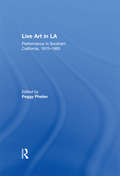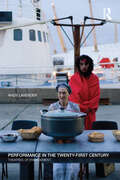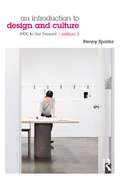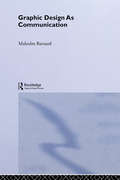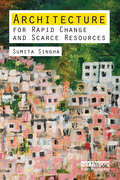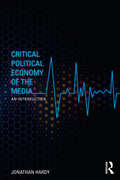- Table View
- List View
Using the Visual Arts for Cross-curricular Teaching and Learning: Imaginative ideas for the primary school
by Karen Hosack JanesAs schools are being encouraged to develop more flexible and creative approaches to education, Using the Visual Arts for Cross-curricular Teaching and Learning provides practical guidance and ideas on using the visual arts as a starting point for imaginative, effective learning across a wide range of curriculum subjects. Underpinned by established and current educational thinking, it uses real-life examples to explore how this approach has been used successfully by individual class teachers and as whole-school projects. Offering proven strategies supporting the principles of personalized learning, it will help you involve children in devising cross-curricular themes and setting their own lines of enquiry. Supplemented throughout with case studies and ideas for great artworks to get projects started, as well as examples of children’s own work, it explores: developing individual pupils' talent and respect for their own and other cultures; using a single painting as a starting point for learning in a range of subjects; finding inspiration for your own cross-curricular projects using the visual arts; underpinning all activities with educational purpose; planning for and assessing progression in learning; discovering and using art resources in your region. The tried and tested strategies in Using the Visual Arts for Cross-curricular Teaching and Learning will give all primary school teachers the confidence to explore the benefits of placing the visual arts at the centre of a creative, appealing curriculum.
Using the Visual Arts for Cross-curricular Teaching and Learning: Imaginative ideas for the primary school
by Karen Hosack JanesAs schools are being encouraged to develop more flexible and creative approaches to education, Using the Visual Arts for Cross-curricular Teaching and Learning provides practical guidance and ideas on using the visual arts as a starting point for imaginative, effective learning across a wide range of curriculum subjects. Underpinned by established and current educational thinking, it uses real-life examples to explore how this approach has been used successfully by individual class teachers and as whole-school projects. Offering proven strategies supporting the principles of personalized learning, it will help you involve children in devising cross-curricular themes and setting their own lines of enquiry. Supplemented throughout with case studies and ideas for great artworks to get projects started, as well as examples of children’s own work, it explores: developing individual pupils' talent and respect for their own and other cultures; using a single painting as a starting point for learning in a range of subjects; finding inspiration for your own cross-curricular projects using the visual arts; underpinning all activities with educational purpose; planning for and assessing progression in learning; discovering and using art resources in your region. The tried and tested strategies in Using the Visual Arts for Cross-curricular Teaching and Learning will give all primary school teachers the confidence to explore the benefits of placing the visual arts at the centre of a creative, appealing curriculum.
Planning in the USA: Policies, Issues, and Processes
by J. Barry Cullingworth Roger CavesThis extensively revised and updated fourth edition of Planning in the USA continues to provide a comprehensive introduction to the policies, theory and practice of planning. Outlining land use, urban planning, and environmental protection policies, this fully illustrated book explains the nature of the planning process and the way in which policy issues are identified, defined, and approached. This full colour edition incorporates new planning legislation and regulations at the state and federal layers of government, updated discussion on current economic issues, and examples of local ordinances in a variety of planning areas. Key updates include: a new chapter on planning and sustainability; a new discussion on the role of foundations and giving to communities; a discussion regarding the aftermath of Katrina in New Orleans; a discussion on deindustrialization and shrinking cities; a discussion on digital billboards; a discussion on recent comprehensive planning efforts; a discussion on land banking; a discussion unfunded mandates; a discussion on community character; a companion website with multiple choice and fill the blank questions, and ‘test yourself’ glossary terms. This book gives a detailed account of urbanization in the United States and reveals the problematic nature and limitations of the planning process, the fallibility of experts, and the difficulties facing policy-makers in their search for solutions. Planning in the USA is an essential book for students, planners and all who are concerned with the nature of contemporary urban and environmental problems.
Planning in the USA: Policies, Issues, and Processes
by J. Barry Cullingworth Roger CavesThis extensively revised and updated fourth edition of Planning in the USA continues to provide a comprehensive introduction to the policies, theory and practice of planning. Outlining land use, urban planning, and environmental protection policies, this fully illustrated book explains the nature of the planning process and the way in which policy issues are identified, defined, and approached. This full colour edition incorporates new planning legislation and regulations at the state and federal layers of government, updated discussion on current economic issues, and examples of local ordinances in a variety of planning areas. Key updates include: a new chapter on planning and sustainability; a new discussion on the role of foundations and giving to communities; a discussion regarding the aftermath of Katrina in New Orleans; a discussion on deindustrialization and shrinking cities; a discussion on digital billboards; a discussion on recent comprehensive planning efforts; a discussion on land banking; a discussion unfunded mandates; a discussion on community character; a companion website with multiple choice and fill the blank questions, and ‘test yourself’ glossary terms. This book gives a detailed account of urbanization in the United States and reveals the problematic nature and limitations of the planning process, the fallibility of experts, and the difficulties facing policy-makers in their search for solutions. Planning in the USA is an essential book for students, planners and all who are concerned with the nature of contemporary urban and environmental problems.
Live Art in LA: Performance in Southern California, 1970 - 1983
by Peggy PhelanLive Art in LA: Performance Art in Southern California , 1970-1983 documents and critically examines one of the most fecund periods in the history of live art. The book forms part of the Getty Institute’s Pacific Standard Time initiative – a series of exhibitions, performance re-enactments and research projects focused on the greater Los Angeles area. This extraordinary volume, beautifully edited by one of the leading scholars in the field, makes vivid the compelling drama of performance history on the west coast. Live Art in LA: moves lucidly between discussions of legendary figures such as Judy Chicago and Chris Burden, and the crucial work of less-celebrated solo artists and collectives; examines the influence of key institutions, particularly Los Angeles Contemporary Exhibitions and the California Institute of the Arts – and the Feminist Art Programme established at the latter; features original and incisive essays by Peggy Phelan and Amelia Jones, and eloquent contributions by Michael Ned Holte, Suzanne Lacy and Jennifer Flores Sternad. Combining cutting-edge research with over 100 challenging and provocative photographs and video stills, Live Art in LA represents a major re-evaluation of a crucial moment in performance history. And, as performance studies becomes ever more relevant to the history of art, promises to become a vital and enduring resource for students, academics and artists alike.
Live Art in LA: Performance in Southern California, 1970 - 1983
by Peggy PhelanLive Art in LA: Performance Art in Southern California , 1970-1983 documents and critically examines one of the most fecund periods in the history of live art. The book forms part of the Getty Institute’s Pacific Standard Time initiative – a series of exhibitions, performance re-enactments and research projects focused on the greater Los Angeles area. This extraordinary volume, beautifully edited by one of the leading scholars in the field, makes vivid the compelling drama of performance history on the west coast. Live Art in LA: moves lucidly between discussions of legendary figures such as Judy Chicago and Chris Burden, and the crucial work of less-celebrated solo artists and collectives; examines the influence of key institutions, particularly Los Angeles Contemporary Exhibitions and the California Institute of the Arts – and the Feminist Art Programme established at the latter; features original and incisive essays by Peggy Phelan and Amelia Jones, and eloquent contributions by Michael Ned Holte, Suzanne Lacy and Jennifer Flores Sternad. Combining cutting-edge research with over 100 challenging and provocative photographs and video stills, Live Art in LA represents a major re-evaluation of a crucial moment in performance history. And, as performance studies becomes ever more relevant to the history of art, promises to become a vital and enduring resource for students, academics and artists alike.
Performance in the Twenty-First Century: Theatres of Engagement
by Andy LavenderPerformance in the Twenty-First Century: Theatres of Engagement addresses the reshaping of theatre and performance after postmodernism. Andy Lavender argues provocatively that after the ‘classic’ postmodern tropes of detachment, irony, and contingency, performance in the twenty-first century engages more overtly with meaning, politics and society. It involves a newly pronounced form of personal experience, often implicating the body and/or one’s sense of self. This volume examines a range of performance events, including work by both emergent and internationally significant companies and artists such as Rimini Protokoll, Blast Theory, dreamthinkspeak, Zecora Ura, Punchdrunk, Ontroerend Goed, Kris Verdonck, Dries Verhoeven, Rabih Mroué, Derren Brown and David Blaine. It also considers a wider range of cultural phenomena such as online social networking, sports events, installations, games-based work and theme parks, where principles of performance are in play. Performance in the Twenty-First Century is a compelling and provocative resource for anybody interested in discovering how performance theory can be applied to cutting-edge culture, and indeed the world around them.
The Guided Reader to Teaching and Learning History
by Richard Harris Katharine Burn Mary WoolleyThe Guided Reader to Teaching and Learning History draws on extracts from the published work of some of the most influential history education writers, representing a range of perspectives from leading classroom practitioners to academic researchers, and highlighting key debates surrounding a central range of issues affecting secondary History teachers. This book brings together key extracts from classic and contemporary writing and contextualises these in both theoretical and practical terms. Each extract is accompanied by an introduction, a summary of the key points and issues raised, questions to promote discussion and suggestions for further reading to extend thinking. Taking a thematic approach and including a short introduction to each theme, the chapters include: The purpose of history education; Pupil perspectives on history education; Assessment and progression in history; Inclusion in history; Diversity in history; Teaching difficult issues; Technology and history education; Change and continuity; Historical Interpretations; Professional development for history teachers. Aimed at trainee and newly qualified teachers including those working towards Masters level qualifications, as well as existing teachers, this accessible, but critically provocative text is an essential resource for those that wish to deepen their understanding of History Education.
An Introduction to Design and Culture: 1900 to the Present
by Penny SparkeThis third edition of An Introduction to Design and Culture has been revised and updated throughout to include issues of globalization, sustainability and digital/interactive design. New for this edition is a chapter which covers key changes in design culture. Design culture has changed dramatically in the 21st century, the designer-hero is now much less in evidence and design has become much more interdisciplinary. Drawing on a wealth of mass-produced artefacts, images and environments including sewing machines, cars, televisions, clothes, electronic and branded goods and exhibitions, author Penny Sparke shows how design has helped to shape and reflect our social and cultural development. This introduction to the development of modern (and postmodern) design is ideal for undergraduate students.
An Introduction to Design and Culture: 1900 to the Present
by Penny SparkeThis third edition of An Introduction to Design and Culture has been revised and updated throughout to include issues of globalization, sustainability and digital/interactive design. New for this edition is a chapter which covers key changes in design culture. Design culture has changed dramatically in the 21st century, the designer-hero is now much less in evidence and design has become much more interdisciplinary. Drawing on a wealth of mass-produced artefacts, images and environments including sewing machines, cars, televisions, clothes, electronic and branded goods and exhibitions, author Penny Sparke shows how design has helped to shape and reflect our social and cultural development. This introduction to the development of modern (and postmodern) design is ideal for undergraduate students.
Why Art Photography?
by Lucy SoutterContemporary art photography is paradoxical. Anyone can look at it and form an opinion about what they see, yet it represents critical positions that only a small minority of well-informed viewers can usually access. Why Art Photography? provides a lively, accessible introduction to the ideas behind today’s striking photographic images. Exploring key issues such as ambiguity, objectivity, staging, authenticity, the digital and photography’s expanded field, the chapters offer fresh perspectives on existing debates. While the main focus is on the present, the book traces concepts and visual styles to their origins, drawing on carefully selected examples from recognized international photographers. Images, theories and histories are described in a clear, concise manner and key terms are defined along the way. This book is ideal for anyone wanting to deepen their understanding of photography as an art form.
Why Art Photography?
by Lucy SoutterContemporary art photography is paradoxical. Anyone can look at it and form an opinion about what they see, yet it represents critical positions that only a small minority of well-informed viewers can usually access. Why Art Photography? provides a lively, accessible introduction to the ideas behind today’s striking photographic images. Exploring key issues such as ambiguity, objectivity, staging, authenticity, the digital and photography’s expanded field, the chapters offer fresh perspectives on existing debates. While the main focus is on the present, the book traces concepts and visual styles to their origins, drawing on carefully selected examples from recognized international photographers. Images, theories and histories are described in a clear, concise manner and key terms are defined along the way. This book is ideal for anyone wanting to deepen their understanding of photography as an art form.
Graphic Design as Communication
by Malcolm BarnardWhat is the point of graphic design? Is it advertising or is it art? What purpose does it serve in our society and culture? Malcolm Barnard explores how meaning and identity are at the core of every graphic design project and argues that the role and function of graphic design is, and always has been, communication.Drawing on a range of theoretical approaches including those of Derrida, Saussure, Foucault, and Barthes, and taking examples from advertising, magazines, illustration, website design, comics, greetings cards and packaging, Graphic Design as Communication looks at how graphic design contributes to the formation of social and cultural identities. Malcolm Barnard discusses the ways in which racial/ethnic groups, age groups and gender groups are represented in graphic design, as well as how images and texts communicate with different cultural groups. He also explores how graphic design relates to both European and American modernism, and its relevance to postmodernism and globalisation in the twenty-first century and asks why, when graphic design is such an integral part of our society and culture, it is not acknowledged and understood in the same way that art is.
Graphic Design as Communication
by Malcolm BarnardWhat is the point of graphic design? Is it advertising or is it art? What purpose does it serve in our society and culture? Malcolm Barnard explores how meaning and identity are at the core of every graphic design project and argues that the role and function of graphic design is, and always has been, communication.Drawing on a range of theoretical approaches including those of Derrida, Saussure, Foucault, and Barthes, and taking examples from advertising, magazines, illustration, website design, comics, greetings cards and packaging, Graphic Design as Communication looks at how graphic design contributes to the formation of social and cultural identities. Malcolm Barnard discusses the ways in which racial/ethnic groups, age groups and gender groups are represented in graphic design, as well as how images and texts communicate with different cultural groups. He also explores how graphic design relates to both European and American modernism, and its relevance to postmodernism and globalisation in the twenty-first century and asks why, when graphic design is such an integral part of our society and culture, it is not acknowledged and understood in the same way that art is.
Planning for Sustainability: Creating Livable, Equitable and Ecological Communities
by Stephen M. WheelerHow can human communities sustain a long-term existence on a small planet? This challenge grows ever more urgent as the threat of global warming increases. Planning for Sustainability presents a wide-ranging, intellectually well-grounded and accessible introduction to the concept of planning for more sustainable and livable communities. The text explores topics such as how more compact and walkable cities and towns might be created, how local ecosystems can be restored, how social inequalities might be reduced, how greenhouse gas emissions might be lowered, and how more sustainable forms of economic development can be brought about. The second edition has been extensively revised and updated throughout, including an improved structure with chapters now organized under three sections: the nature of sustainable planning, issues central to sustainable planning, and scales of sustainable planning. New material includes greater discussion of climate change, urban food systems, the relationships between public health and the urban environment, and international development. Building on past schools of planning theory, Planning for Sustainability lays out a sustainability planning framework that pays special attention to the rapidly evolving institutions and power structures of a globalizing world. By considering in turn each scale of planning—international, national, regional, municipal, neighborhood, and site and building—the book illustrates how sustainability initiatives at different levels can interrelate. Only by weaving together planning initiatives and institutions at different scales, and by integrating efforts across disciplines, can we move towards long-term human and ecological well-being.
Image Studies: Theory and Practice
by Sunil ManghaniImage Studies offers an engaging introduction to visual and image studies. In order to better understand images and visual culture the book seeks to bridge between theory and practice; asking the reader to think critically about images and image practices, but also simultaneously to make images and engage with image-makers and image-making processes. Looking across a range of domains and disciplines, we find the image is never a single, static thing. Rather, the image can be a concept, an object, a picture, or medium – and all these things combined. At the heart of this book is the idea of an ‘ecology of images’, through which we can examine the full ‘life’ of an image – to understand how an image resonates within a complex set of contexts, processes and uses. Part 1 covers theoretical perspectives on the image, supplemented with practical entries on making, researching and writing with images. Part 2 explores specific image practices and cultures, with chapters on drawing and painting; photography; visual culture; scientific imaging; and informational images. A wide range of illustrations complement the text throughout and each chapter includes creative tasks, keywords (linked to an online resource), summaries and suggested further reading. In addition, each of the main chapters include selected readings by notable authors across a range of subject areas, including: Art History, Business, Cognitive Science, Communication Studies, Infographics, Neuroscience, Photography, Physics, Science Studies, Social Semiotics, Statistics, and Visual Culture.
Image Studies: Theory and Practice
by Sunil ManghaniImage Studies offers an engaging introduction to visual and image studies. In order to better understand images and visual culture the book seeks to bridge between theory and practice; asking the reader to think critically about images and image practices, but also simultaneously to make images and engage with image-makers and image-making processes. Looking across a range of domains and disciplines, we find the image is never a single, static thing. Rather, the image can be a concept, an object, a picture, or medium – and all these things combined. At the heart of this book is the idea of an ‘ecology of images’, through which we can examine the full ‘life’ of an image – to understand how an image resonates within a complex set of contexts, processes and uses. Part 1 covers theoretical perspectives on the image, supplemented with practical entries on making, researching and writing with images. Part 2 explores specific image practices and cultures, with chapters on drawing and painting; photography; visual culture; scientific imaging; and informational images. A wide range of illustrations complement the text throughout and each chapter includes creative tasks, keywords (linked to an online resource), summaries and suggested further reading. In addition, each of the main chapters include selected readings by notable authors across a range of subject areas, including: Art History, Business, Cognitive Science, Communication Studies, Infographics, Neuroscience, Photography, Physics, Science Studies, Social Semiotics, Statistics, and Visual Culture.
An Introduction to Television Studies
by Jonathan BignellIn this comprehensive textbook, now updated for its third edition, Jonathan Bignell provides students with a framework for understanding the key concepts and main approaches to Television Studies, including audience research, television history and broadcasting policy, and the analytical study of individual programmes. Features include: a glossary of key terms key terms defined in margins suggestions for further reading activities/assignments for use in class New and updated case studies feature: ‘Every Home Needs a Harvey’ ad approaches to news reporting television scheduling CSI Crime Scene Investigation animated cartoon series Individual chapters address: studying television, television histories, television cultures, television texts and narratives, television genres and formats, television production, television and quality, television realities, television you can’t see, television audiences, beyond television.
An Introduction to Television Studies
by Jonathan BignellIn this comprehensive textbook, now updated for its third edition, Jonathan Bignell provides students with a framework for understanding the key concepts and main approaches to Television Studies, including audience research, television history and broadcasting policy, and the analytical study of individual programmes. Features include: a glossary of key terms key terms defined in margins suggestions for further reading activities/assignments for use in class New and updated case studies feature: ‘Every Home Needs a Harvey’ ad approaches to news reporting television scheduling CSI Crime Scene Investigation animated cartoon series Individual chapters address: studying television, television histories, television cultures, television texts and narratives, television genres and formats, television production, television and quality, television realities, television you can’t see, television audiences, beyond television.
Architecture for Rapid Change and Scarce Resources
by Sumita SinhaArchitects, development practitioners and designers are working in a global environment and issues such as environmental and cultural sustainability matter more than ever. Past interactions and interventions between developed and developing countries have often been unequal and inappropriate. We now need to embrace fresh design practices based on respect for diversity and equality, participation and empowerment. This book explores what it means for development activists to practise architecture on a global scale, and provides a blueprint for developing architectural practices based on reciprocal working methods. The content is based on real situations - through extended field research and contacts with architecture schools and architects, as well as participating NGOs. It demonstrates that the ability to produce appropriate and sustainable design is increasingly relevant, whether in the field of disaster relief, longer-term development or wider urban contexts, both in rich countries and poor countries.
Rethinking Dance History: A Reader
by Larraine Nicholas Geraldine MorrisBy taking a fresh approach to the study of history in general, Alexandra Carter's Rethinking Dance History offers new perspectives on important periods in dance history and seeks to address some of the gaps and silences left within that history. Encompassing ballet, South Asian, modern dance forms and much more, this book provides exciting new research on topics as diverse as: *the Victorian music hall *film musicals and popular music videos *the impact of Neoclassical fashion on ballet *women's influence on early modern dance *methods of dance reconstruction. Featuring work by some of the major voices in dance writing and discourse, this unique anthology will prove invaluable for both scholars and practitioners, and a source of interest for anyone who is fascinated by dance's rich and multi-layered history.
Rethinking Dance History: A Reader
by Larraine Nicholas Geraldine MorrisBy taking a fresh approach to the study of history in general, Alexandra Carter's Rethinking Dance History offers new perspectives on important periods in dance history and seeks to address some of the gaps and silences left within that history. Encompassing ballet, South Asian, modern dance forms and much more, this book provides exciting new research on topics as diverse as: *the Victorian music hall *film musicals and popular music videos *the impact of Neoclassical fashion on ballet *women's influence on early modern dance *methods of dance reconstruction. Featuring work by some of the major voices in dance writing and discourse, this unique anthology will prove invaluable for both scholars and practitioners, and a source of interest for anyone who is fascinated by dance's rich and multi-layered history.
Critical Political Economy of the Media: An Introduction
by Jonathan HardyHow the media are organised and funded is central to understanding their role in society. Critical Political Economy of the Media provides a clear, comprehensive and insightful introduction to the political economic analysis of contemporary media. Jonathan Hardy undertakes a critical survey of political economy scholarship encompassing worldwide literature, issues and debates, and relationships with other academic approaches. He assesses different ways of making sense of media convergence and digitalisation, media power and influence, and transformations across communication markets. Many of the problems of the media that prompted critical political economy research remain salient, he argues, but the approach must continue to adapt to new conditions and challenges. Hardy advances the case for a revitalised critical media studies for the 21st century. Topics covered include: media ownership and financing news and entertainment convergence and the Internet media globalisation advertising and media alternative media media policy and regulation Introducing key concepts and research, this book explains how political economy can assist students, researchers and citizens to investigate and address vital questions about the media today.
Critical Political Economy of the Media: An Introduction
by Jonathan HardyHow the media are organised and funded is central to understanding their role in society. Critical Political Economy of the Media provides a clear, comprehensive and insightful introduction to the political economic analysis of contemporary media. Jonathan Hardy undertakes a critical survey of political economy scholarship encompassing worldwide literature, issues and debates, and relationships with other academic approaches. He assesses different ways of making sense of media convergence and digitalisation, media power and influence, and transformations across communication markets. Many of the problems of the media that prompted critical political economy research remain salient, he argues, but the approach must continue to adapt to new conditions and challenges. Hardy advances the case for a revitalised critical media studies for the 21st century. Topics covered include: media ownership and financing news and entertainment convergence and the Internet media globalisation advertising and media alternative media media policy and regulation Introducing key concepts and research, this book explains how political economy can assist students, researchers and citizens to investigate and address vital questions about the media today.
Exercises in Architecture: Learning to Think as an Architect
by Simon UnwinArchitecture is a doing word. You can learn a great deal about the workings of architecture through analysing examples but a fuller understanding of its powers and potential comes through practice, by trying to do it... This book offers student architects a series of exercises that will develop their capacity for doing architecture. Exercises in Architecture builds on and supplements the methodology for architectural analysis presented in the author’s previous book Analysing Architecture (third edition, Routledge, 2009) and demonstrated in his Twenty Buildings Every Architect Should Understand (Routledge, 2010). The three books taken together deal with the three aspects of learning: description, analysis of examples, and practice. The book offers twelve exercises, each divided into a short series of tasks aimed at developing a particular theme or area of architectural capacity. The exercises deal with themes such as place-making, learning through drawing, framing, light, , uses of geometry, stage setting, eliciting emotional responses, the genetics of detail and so forth.


